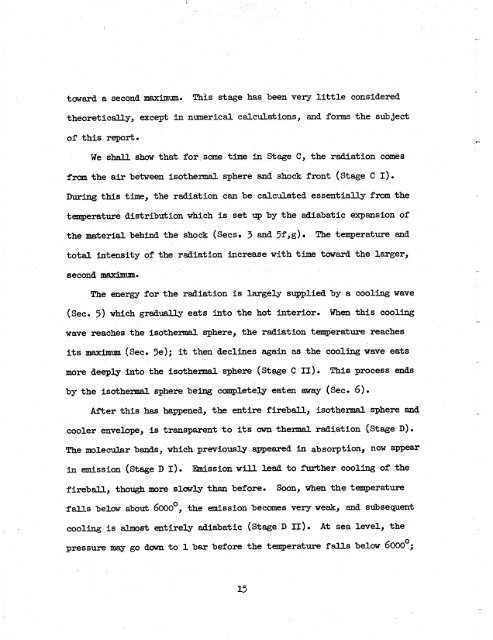Theory of the Fireball
Theory of the Fireball
Theory of the Fireball
You also want an ePaper? Increase the reach of your titles
YUMPU automatically turns print PDFs into web optimized ePapers that Google loves.
toward a .second maximum. This stage has been very little considered<br />
<strong>the</strong>oretically, except in numerical calculations, and forms <strong>the</strong> subject<br />
<strong>of</strong> this report.<br />
We shall show that for some time In Stage Cy <strong>the</strong> radiation comes<br />
fm <strong>the</strong> air between iso<strong>the</strong>rmal sphere and shock front (Stage C I) .<br />
During this time, <strong>the</strong> radiation can be calculated essentially from <strong>the</strong><br />
temperature distribution which is set up by <strong>the</strong> adiabatic expansion <strong>of</strong><br />
<strong>the</strong> material behind <strong>the</strong> shock (Secs 3 and 5f ,g) The temperature and<br />
total intensity <strong>of</strong> <strong>the</strong> radiation increase with time toward <strong>the</strong> larger,<br />
second maximum.<br />
The energy for<strong>the</strong> radiation is largely sqplied by a cooling wave<br />
(Sec. 5) which gradually eats into <strong>the</strong> hot interior. When this coollng<br />
wave reaches <strong>the</strong> iso<strong>the</strong>rmal sphere, <strong>the</strong> radiation temperature reaches<br />
its maximum (Sec. 5e); it <strong>the</strong>n declines again as <strong>the</strong> cooling wave eats<br />
more deeply into <strong>the</strong> iso<strong>the</strong>rmal sphere (Stage C 11). This process ends<br />
by <strong>the</strong> iso<strong>the</strong>rmal sphere being comgletely eaten away (Sec. 6) .<br />
mer this has happened, <strong>the</strong> entire fireball, iso<strong>the</strong>rmal sphere and<br />
cooler envelope, is transparent to its own <strong>the</strong>rmal. radiation (Stage D) .<br />
The molecular bands, which previously appeared in absorption, now appear<br />
in emission (Stage D I) . Emission w ill lead to fur<strong>the</strong>r coollng <strong>of</strong> <strong>the</strong><br />
fireball, though more slowly than before. Soon, when <strong>the</strong> temperature<br />
falls below about 6000°, <strong>the</strong> emission becomes very weak, and stibsequent<br />
cooling is almost entirely adiabatic (Stage D 11) . A t sea level, <strong>the</strong><br />
pressure may go down to 1 bar before <strong>the</strong> temperature falls belaw 6000~;<br />
c
















